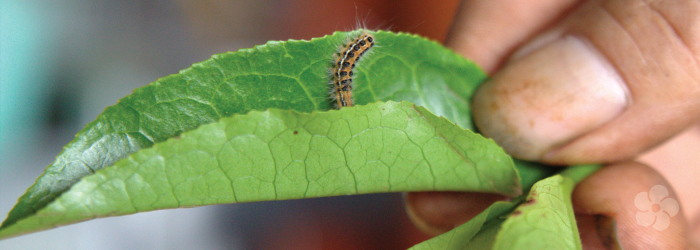3 Sustainable Approaches to Pest Control

Traditional tea farms in China and Taiwan usually occupy land passed down through the generations, along with the skills needed to grow and craft tea. In historic tea producing regions, the farmers often maintain traditional growing methods and craftsmanship as well. Limited by relatively small land area, individual family farms are incentivized to focus on quality instead of quantity, since quality examples of traditional styles from famous regions are highly coveted.
Most independent farmers take great pride in the reputation of their tea and their land, and seek sustainable growing methods that they can continue to pass down to their descendants. This includes finding natural ways to control pests, without using toxic insecticides. Here are a few of the natural methods we’ve seen traditional farmers using to manage pest threats.
1. Protective Companion Crops
Some plants have evolved with potent defense mechanisms to defend themselves against insect attacks. Chrysanthemum and camphor trees are two of the best known candidates in tea growing regions. Both contain natural compounds that are toxic to insects. Today, they are often synthesized into commercial pest repellants, but the farmers we work with simply plant them nearby, or even among the tea plants. Their presence effectively limits pest populations in the area without the use of any chemicals. This is one of the most traditional methods of pest control.
2. Insect Traps
In the Wuyi Mountains, inventive farmers have devised another, more modern method, using a simple setup of a light bulb positioned over a pan of water. Solar energy stored during the day powers the bulb at night. Bugs drawn to the light source are efficiently deposited into the waiting pan of water. This innovative contraption uses modern technology to maintain sustainable practices.
3. Crafting Mi Xiang Teas
In Taiwan, many traditional farmers are embracing the insects, in the tradition of Oriental Beauty tea. Essentially, the tea’s natural defense against insects is to release specialized enzymes and send more sugars to the damaged leaves to promote growth and recovery. This produces a naturally sweet flavor and honey-like fragrance in the leaf.
As the enzymatic reaction is different in response to different bug species, it was traditionally thought that only the Taiwanese leafhoppers known to create Oriental Beauty would have this effect. But more recently, researchers have found that the Chinese leafhopper is the same species, and other insect bites can produce similar effects in properly crafted leaves.
The trend of mi xiang (“honey fragrance”) leaves is now spreading across Taiwan and mainland China. Though insect damage can cause a large part of the crop to be lost, the impressive flavors that result can command higher prices for the remaining leaves. In the case of our Formosa Red Assam, Mi Xiang, for instance, the combination of a robust black tea variety and the mi xiang effect results in a tea with all the body of an English Breakfast but none of the bite.
We take pride in the sustainable nature of our teas, just as the farmers that grow them do. These traditional methods of pest control help small farmers maximize the profits of their business without resorting to toxic chemicals, and help ensure that future generations will also be able to enjoy the sublime flavors of high quality traditional teas.
Read about why sustainable teas aren't always certified organic >>
Sign up for our newsletter to get blog updates in your inbox!






Comments on this post (0)